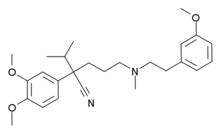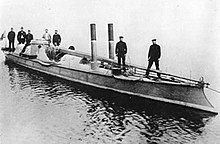데바파밀
Devapamil | |
| 이름 | |
|---|---|
| IUPAC 이름 (RS)-2-(3,4-디메트호섹페닐)-2-이소프로필-5-[2-(3-메톡시페닐)에틸-메틸아미노]펜타니트리글 | |
| 식별자 | |
3D 모델(JSmol) | |
| 체비 | |
| 켐벨 | |
| 켐스파이더 | |
펍켐 CID | |
| 유니 | |
| |
| |
| 특성. | |
| C26H36N2O3 | |
| 어금질량 | 424.57564 |
달리 명시된 경우를 제외하고, 표준 상태(25°C [77°F], 100 kPa)의 재료에 대한 데이터가 제공된다. | |
| Infobox 참조 자료 | |
데바파밀은 칼슘 통로 차단제다. 페닐알킬아민(PAA) 유도체인 데스메톡시베라파밀(desmethoxyverapamil)으로도 알려져 있다.[1] 데바파밀은 칼슘 게이트 채널을 차단하여 억제할 뿐만 아니라 나트륨-칼륨 교환 시 막의 탈분극화 작용도 억제한다.[2]
구조
데바파밀은 알킬아민 체인에 의해 연결된 메톡시 대체물이 있는 두 개의 방향족 고리로 구성되어 있어 유연성과 전체적인 효능을 높인다.[3]
동물학
쥐의 데바파밀은 글루타티온 수치를 낮추고 지질의 산화를 증가시키는 데 사용될 수 있어 스트레스로 인한 궤양의 사전 차단에도 효과적이다.[4][5] 이 약물과 다른 페닐알킬아밀라민의 의학적 특성은 더 큰 친화력과 약물 효율을 초래하는 대상 칼슘 채널의 상태에 크게 좌우된다. [6]
참조
- ^ Erdmann R, Lüttgau HC (June 1989). "The effect of the phenylalkylamine D888 (devapamil) on force and Ca2+ current in isolated frog skeletal muscle fibres". The Journal of Physiology. 413 (1): 521–41. doi:10.1113/jphysiol.1989.sp017667. PMC 1189114. PMID 2557440.
- ^ Dierkes PW, Wende V, Hochstrate P, Schlue WR (July 2004). "L-type Ca2+ channel antagonists block voltage-dependent Ca2+ channels in identified leech neurons". Brain Research. 1013 (2): 159–67. doi:10.1016/j.brainres.2004.03.038. PMID 15193524. S2CID 22004238.
- ^ Cheng RC, Tikhonov DB, Zhorov BS (October 2009). "Structural model for phenylalkylamine binding to L-type calcium channels". The Journal of Biological Chemistry. 284 (41): 28332–42. doi:10.1074/jbc.M109.027326. PMC 2788883. PMID 19700404.
- ^ Alican I, Toker F, Arbak S, Yegen BC, Yalçin AS, Oktay S (August 1994). "Gastric lipid peroxidation, glutathione and calcium channel blockers in the stress-induced ulcer model in rats". Pharmacological Research. 30 (2): 123–35. doi:10.1016/1043-6618(94)80004-9. PMID 7816741.
- ^ Hung CR (May 2004). "Protective effects of lysozyme chloride and reduced glutathione on betel quid chewing-produced gastric oxidative stress and haemorrhagic ulcer in rats". Inflammopharmacology. 12 (2): 115–29. doi:10.1163/1568560041352284. PMID 15265315. S2CID 860321.
- ^ Cheng RC, Tikhonov DB, Zhorov BS (October 2009). "Structural model for phenylalkylamine binding to L-type calcium channels". The Journal of Biological Chemistry. 284 (41): 28332–42. doi:10.1074/jbc.M109.027326. PMC 2788883. PMID 19700404.


